Occupational environment monitoring at the factory producing poultry eggs
99,000 ₫
Note: The above price is calculated for one sample, the price may fluctuate depending on the area of the environment to be monitored and the movement of the market. For more accurate price support, please refer to the quotation table or contact directly with our consulting staff.
Environmental monitoring of poultry egg production factories is a session of collecting, analyzing, and evaluating factors in the workplace that may be harmful to the health of workers.
Table of Contents
Toggle1. Overview of Poultry Egg Production Factories
a. What is a poultry egg production factory?
Egg production factory is a facility for mass production of poultry eggs, including chicken eggs, duck eggs, Muscovy duck eggs, quail eggs, and eggs from other types of poultry. The factory has processes and systems for raising and caring for poultry, collecting and processing eggs, ensuring the production and supply of high-quality and safe eggs to the consumer market.
The production stages in a poultry egg factory include raising and caring for poultry, collecting eggs, processing and preserving eggs. These processes comply with hygiene, food safety, and quality management regulations to ensure that the produced eggs meet standards and are safe for consumers.

b. Production stages in a poultry egg production factory
The production stages in a poultry egg factory include:
- Raising and caring for poultry: The factory has areas for poultry housing, designed to meet space, lighting, and temperature requirements, ensuring comfort and health for the birds. This includes feeding, providing water, managing nutrition, controlling diseases, and monitoring poultry health.
- Egg collection: When poultry lay eggs, staff collect eggs from the housing areas. This process includes identifying laid eggs, inspecting their integrity and quality.
- Egg processing and preservation: After collection, eggs are processed to ensure food safety and long-term preservation. These steps may include washing eggs to remove dirt, egg residue, or impurities, inspecting for damaged eggs, packaging, and labeling eggs with production dates and origin information.
- Quality inspection: Before reaching consumers, eggs undergo quality checks to ensure compliance with standards for shape, size, color, and internal quality.
- Hygiene and food safety management: Poultry egg factories must comply with hygiene and food safety regulations to ensure eggs are safe and do not harm consumers.
- Packing and dispatching: After the above stages, eggs are properly packed and prepared for dispatch and distribution.

c. Types of machinery used in poultry egg production factories
Poultry egg production factories use various machinery and equipment to support production. Common machines include:
- Automatic egg collection machine: Used to automatically collect eggs from poultry housing, improving efficiency and saving time.
- Automatic egg washing machine: Used to clean eggs after collection, removing dirt and impurities from the surface.
- Egg integrity inspection machine: Checks egg integrity and removes damaged or cracked eggs.
- Egg marking machine: Labels eggs with production dates, origin, and other details.
- Automatic egg packing machine: Packs eggs into boxes or packaging for transportation and sales.
- Egg storage and management system: Includes equipment and systems for storing and managing large quantities of eggs, such as refrigeration, warehouse management, and monitoring systems.
- Egg grading machine: Sorts eggs by size, color, or other factors for consumer and export requirements.
- Automatic egg breaking machine: Breaks eggs for processing or production of egg-based products.

d. Occupational diseases that workers in poultry egg factories may face
Workers in poultry egg factories may be exposed to some occupational diseases related to their work. Common occupational diseases in this industry include:
- Allergies and rhinitis: Exposure to pollen, dust, and allergens can cause allergic reactions and rhinitis.
- Respiratory inflammation: Workers may inhale harmful gases or dust from poultry manure, causing respiratory inflammation and issues.
- Dermatitis: Exposure to additives, chemicals, and other irritants can cause skin inflammation, itching, and other skin problems.
- Spinal and musculoskeletal disorders: Tasks involving heavy lifting, repetitive movements, and poor posture can cause spinal and musculoskeletal issues.
- Hand and neck disorders: Use of tools, machinery, and equipment may cause injuries or disorders in the hands and neck, including tendonitis, bursitis, and joint degeneration.
- Nervous system disorders: Exposure to toxic chemicals, harmful gases, or loud noise may lead to neurological issues such as insomnia, fatigue, mental disorders, and stress.
To reduce occupational disease risks, health and safety measures should be implemented, including providing proper personal protective equipment, ensuring adequate ventilation and exhaust systems, following safe work procedures, and conducting regular health check-ups.

e. Popular types of poultry eggs on the market
Popular poultry eggs on the market include:
- Chicken eggs: The most common, with white or brown shells, oval shape, and medium size.
- Duck eggs: White or blue shells, larger and harder than chicken eggs, with distinct yolk and white.
- Muscovy duck eggs: White or blue shells, larger than chicken eggs, with dark orange yolks.
- Quail eggs: Small eggs with white or brown shells, used in dishes like stir-fry, salads, or egg mixes.
- Pigeon eggs: White or blue shells, larger than chicken eggs, with dark orange yolks.
- Goose eggs: Small eggs with white or pink shells, used in cooking and baking.
2. Overview of occupational environment monitoring services
a. What is occupational environment monitoring in poultry egg factories?
Occupational environment monitoring (or labor environment measurement) in poultry egg factories involves collecting, evaluating, and analyzing measurement indicators of workplace environmental factors. This is done to implement timely measures, reduce environmental impacts on worker health, and prevent occupational diseases. Monitoring is mandatory for poultry egg factories.
Occupational environment monitoring plays a critical role in protecting, maintaining, and enhancing worker health, as workers are the primary resource of a business and directly generate its profit. Workers frequently exposed to hazardous factors exceeding allowed limits may suffer health effects and occupational diseases.
REGISTER FOR OCCUPATIONAL ENVIRONMENT MONITORING SERVICE
b. Nam Viet’s occupational environment monitoring program
Nam Viet’s occupational environment monitoring program is developed by monitoring engineers in labor safety and environmental protection. Aiming to ensure worker health and safety, the program uses modern measurement methods to monitor air quality, water, microclimate, physical factors, dust, and more in the workplace. This program is essential for ensuring a safe working environment and protecting worker health.
Additionally, Nam Viet’s program contributes to research and development of solutions to improve workplace environmental quality. With the dedication and professionalism of its monitoring experts, Nam Viet’s proprietary monitoring program is a breakthrough in occupational safety and environmental protection in Vietnam.

c. Standardization in the occupational environment measurement process
Standardization in Nam Viet’s occupational environment measurement process is crucial to ensure the accuracy and reliability of results. The program follows recognized standards and procedures from the Ho Chi Minh City Department of Health. This guarantees that collected data are reliable for evaluating workplace environments and making informed decisions to improve worker health and safety.
These standardized procedures also ensure that measurements are performed by highly qualified monitoring specialists with years of experience, enabling managers and experts to trust An Toàn Nam Việt’s results and make accurate, valuable decisions to protect worker health and the environment.
By applying standardization in occupational environment measurement, Nam Viet demonstrates its commitment to a safe working environment and worker health protection, while actively contributing to the development and enhancement of occupational safety and environmental management in Vietnam.
d. Reporting results of occupational environment monitoring in poultry egg factories
Monitoring results are prepared according to Form No. 04, Appendix III, issued with Decree 44/2016/NĐ-CP and prepared in two copies: one sent to the labor establishment that contracted the monitoring service, and one retained by the monitoring organization.
The retention period for occupational environment monitoring records is indefinite according to legal regulations.

e. Frequency of occupational environment monitoring according to legal regulations
According to Clause 2 of Article 18, Labor Safety and Hygiene Law 84/2015/QH13, employers must organize occupational environment monitoring to evaluate hazardous factors at least once a year.
f. Deadline for submitting occupational environment monitoring reports according to legal regulations
The deadline for submitting reports is before December 31 each year. Enterprises in production facilities are required to submit their monitoring results to the Department of Health at the local jurisdiction where the enterprise’s head office is located and where employees are working.
When there are changes in technology, production processes, or facility upgrades that may generate new hazards to worker health, enterprises must update occupational hygiene records related to hazardous factors requiring monitoring.
g. Penalties for violations of occupational environment monitoring by employers
According to Article 27 of Decree No. 12/2022/NĐ-CP dated January 17, 2022, regulating administrative penalties in labor, social insurance, and Vietnamese employees working abroad under contracts:
- Clause 2: A fine of VND 2,000,000 – 5,000,000 for employers who fail to publicly inform employees at monitoring sites and locations being inspected, evaluated, or managed about the results of occupational environment monitoring and hazardous factor assessments immediately after results are available.
- Clause 3: A fine of VND 20,000,000 – 40,000,000 for employers who do not conduct occupational environment monitoring to control hazards affecting worker health as required by law.
- Clause 4: A fine of VND 40,000,000 – 60,000,000 for employers who collude with monitoring organizations to falsify occupational environment monitoring results but without triggering criminal liability.
3. Harmful environmental factors for workers in poultry egg production factories
Workers in poultry egg production factories may be exposed to several harmful environmental factors. The following are potential factors that may affect their health:
- Ammonia fumes: Poultry manure can produce ammonia, a pungent gas that can irritate the respiratory tract and eyes.
- Poultry dust: The egg processing process can generate dust and particles from eggshells and poultry manure. Prolonged inhalation of poultry dust can cause respiratory irritation.
- Bacteria and microorganisms: Poultry egg production factories may contain numerous pathogenic bacteria and microorganisms, such as Salmonella and E. coli. Exposure to them can cause gastrointestinal infections and other health issues.
- Noise: Machinery and production processes in poultry egg factories can generate high levels of noise, causing stress and affecting hearing.
- Chemicals: The use of chemicals during egg processing, such as cleaning agents and disinfectants, may cause irritation to the skin, eyes, and respiratory system.
- Heat exposure: Poultry egg factories may have hot and humid working environments, especially during egg cooking. High heat exposure can cause fatigue, discomfort, and affect worker health.
REGISTER FOR OCCUPATIONAL ENVIRONMENT MONITORING SERVICE
4. Measures to improve the working environment in poultry egg production factories
To improve the working environment in poultry egg production factories and protect workers’ health, the following measures can be applied:
- Ensure ventilation and dust extraction systems: Install efficient ventilation and dust extraction systems to reduce the accumulation of poultry dust and particles in the workspace.
- Provide personal protective equipment (PPE): Ensure that workers are adequately supplied with and properly use PPE such as masks, gloves, goggles, and chemical-resistant clothing to protect the respiratory system, skin, and eyes.
- Maintain general hygiene: Implement general hygiene measures such as daily cleaning, periodic machine maintenance, and safe disposal of waste to ensure a clean and safe working environment.
- Occupational safety training and education: Provide regular training and education for workers on occupational safety, including proper use of PPE, infection prevention measures, and safe handling of chemicals.
- Periodic inspection and monitoring: Conduct regular workplace inspections to detect early safety and health issues. Ensure environmental monitoring and evaluation are performed according to regulations.
- Ensure comfortable working conditions: Maintain appropriate temperature and humidity, reduce noise, and provide a comfortable working environment for employees.
- Compliance with food safety regulations: Ensure that poultry egg production processes comply with food safety regulations to produce eggs that are safe for consumers.
- Periodically conduct occupational environment monitoring in factories to collect and analyze harmful factors affecting workers, and adjust to reduce risks to prevent occupational diseases.
5. Benefits of periodic monitoring in poultry egg production factories
An Toan Nam Viet provides businesses with outstanding benefits when using occupational environment monitoring services according to Decree 44/2016/ND-CP on the management and control of harmful workplace factors affecting workers.
- Businesses can proactively control harmful factors in workshops or factories.
- Receive recommendations on measures to reduce harmful factors and improve workplace quality.
- Indirectly protect human resources, a key factor in business development.
- Reduce the harmful impact of occupational diseases on human health, lowering future treatment costs.
- Enhance worker health, ensuring product quality and maintaining production output.
- Comply with labor safety laws and avoid legal risks.
- Enhance credibility and professionalism in all aspects, elevating the company brand.
Nam Viet’s environmental monitoring service is a solution to reduce occupational disease risks, contributing to a clean and high-quality working environment.

6. National occupational environment monitoring center
Occupational environment monitoring center of Nam Viet is a professional unit in supervising and measuring occupational environment quality throughout all provinces in Vietnam. With a team of experienced monitoring specialists, the center uses modern measurement equipment to ensure accuracy and reliability.
In addition to monitoring services, the center assists clients in planning, handling, and tracking workplace environmental issues. With the motto “customer-centered,” the center prioritizes customer satisfaction, meets all client needs, and commits to providing the best solutions for businesses.
REGISTER FOR OCCUPATIONAL ENVIRONMENT MONITORING SERVICE
With investment in technology, equipment, and human resources, Nam Viet’s monitoring center has become one of the most reputable units in occupational environment monitoring in Ho Chi Minh City, with the following objectives:
- We always value our brand reputation and service quality.
- We provide customers with the best and most suitable solutions possible.
- Alongside a team of experienced Masters and Engineers, committed to environmental protection and business benefit.
- At Nam Viet Environmental Monitoring, companies receive professional service from field experts and the best cost advantages.
The occupational environment monitoring process at Nam Viet includes the following basic steps:
- Before conducting monitoring, our company ensures all equipment is calibrated according to legal regulations.
- Follow the occupational environment monitoring procedures committed to the Department of Health accurately and fully.
- Report monitoring results honestly to employers.
- If monitoring results indicate unsafe conditions, Nam Viet provides corrective solutions, and the workplace implements the following:
- Implement measures to improve working conditions, minimize harmful factor impacts, and prevent occupational diseases.
- Conduct health examinations to detect occupational and related diseases early for workers in unsafe environments.
- Provide in-kind compensation to workers according to labor law.

7. Occupational environment monitoring quotation
To help businesses conduct professional and effective occupational environment monitoring, Nam Viet provides clients with a quotation for occupational environment monitoring services with quality and reasonable costs.
- Our quotation provides detailed pricing information for the monitoring services we offer, including costs related to travel, measurement, analysis, and reporting. Clients can trust the accuracy and reliability of the monitoring reports we provide.
- We commit to offering competitive and reasonable prices in the market and are always ready to provide quick and professional advice for any inquiries regarding monitoring services.
- With Nam Viet’s monitoring quotation, clients can easily select service packages suitable to their needs. We are committed to delivering the highest satisfaction with professional service quality.
No comments yet

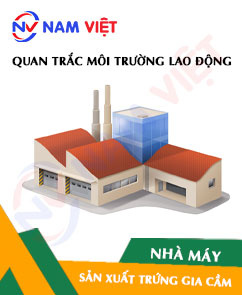
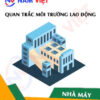
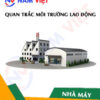

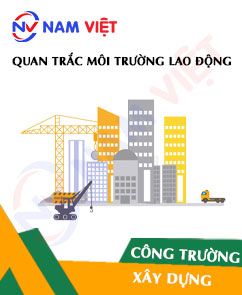

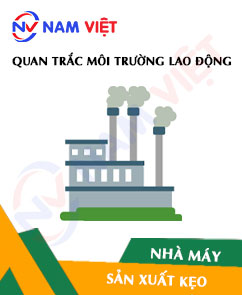
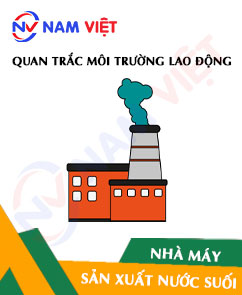



Review Occupational environment monitoring at the factory producing poultry eggs
There are no reviews yet.